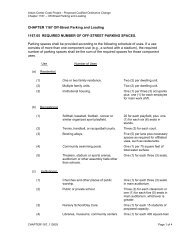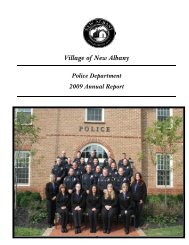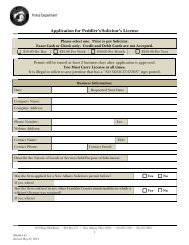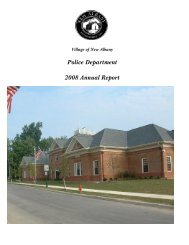NEW ALBANY POLICE DEPARTMENT - New Albany, Ohio
NEW ALBANY POLICE DEPARTMENT - New Albany, Ohio
NEW ALBANY POLICE DEPARTMENT - New Albany, Ohio
You also want an ePaper? Increase the reach of your titles
YUMPU automatically turns print PDFs into web optimized ePapers that Google loves.
If the defendant agrees to a breath test, a certified operator will administer the test. The<br />
operator will have observed the defendant for 20 minutes before the test begins to ensure<br />
the defendant did not consume or place any object in his/her mouth.<br />
If the defendant is wearing dentures, they must be removed, as well as the adhesive,<br />
before the breath test is administered.<br />
After the breath test is completed, the defendant may be provided with the results. If the<br />
result of the test is .08% BAC or higher the officer will seize the defendant’s operator’s<br />
license and charge him/her with the appropriate section of C.O. 333.01(A1) and ALS will<br />
apply. If the result of the test is .17% BAC or higher, the officer will seize the defendant’s<br />
operator’s license and charge him/her with the appropriate section of C.O. 333.01 (A1)<br />
and ALS will apply.<br />
If the defendant has been found guilty of a previous OVI or reckless operation within<br />
six years of his/her arrest, the arresting officer will file the OVI related charges under<br />
state code. The court date given will be within five days of the arrest (see <strong>Ohio</strong><br />
Department of Public Safety Technical Handbook on <strong>Ohio</strong>’s DUI Laws).<br />
If the defendant refuses the test, the officer will mark the appropriate space provided on<br />
BMV Form 2255, seize the defendant’s operator’s license, and place the individual under<br />
an ALS.<br />
B. Under Age Offenders<br />
If an offender is over eighteen years of age but under twenty one years of age, has been<br />
arrested for OVI, and submitted to a breath test and the results of the breath test are at or<br />
above .02% BAC but less than .08% BAC, the officer will charge the defendant with the<br />
appropriate section of C.O. 333.01(A1) OMVUAC. In the event the defendant tests .08%<br />
BAC or higher, the officer will charge the defendant with the appropriate section of C.O.<br />
333.01(A1) and ALS will apply. If an under age offender’s BAC level is less than .02%,<br />
the officer will not charge the defendant with OMVUAC. The officer may issue a citation<br />
or file criminal charges as a result of the traffic stop and subsequent detention.<br />
C. Juvenile Offenders<br />
If an offender who is seventeen years of age or under is arrested for OVI and submits to<br />
a breath test and the results are at or above .02% BAC but less than .08% BAC, the<br />
officer will file the appropriate section of State OVI charges §4511.19(B) (OMVUAC). In<br />
the event the defendant tests below .08% BAC, ALS will not apply. If the defendant tests<br />
.08% BAC or higher, the officer will file the appropriate section of State OVI charges<br />
4511.19(A) and ALS will apply. If a juvenile offender’s BAC level is less than .02%, the<br />
officer will not charge the defendant with OMVUAC. The officer may issue a citation or file<br />
criminal charges as a result of the traffic stop and subsequent detention.<br />
D. Traffic Crashes Involving Impaired Drivers<br />
The investigating officer shall obtain all facts from the scene and interview witnesses<br />
to determine if there are reasonable grounds to believe the driver was impaired at the<br />
time of the crash. If it is determined the driver was impaired at the time of the crash, an<br />
officer will instruct the driver to perform a field sobriety test (see Directive 2.1.9 A). If the<br />
officer determines that the driver is impaired, an arrest will be made and the officer will<br />
follow the procedures as outlined in this chapter.<br />
If a driver who was involved in a traffic crash is injured and/or incapable of performing a<br />
field sobriety test, the investigating officer will request EMS to respond in order to<br />
transport the driver to a medical facility a soon as practical. The investigating officer will<br />
then follow the transporting medic to the medical facility as soon as practical. At the<br />
medical facility, the investigating officer will provide the driver with a copy of BMV Form<br />
2255. The form will be read and shown to the driver while in the presence of a witness.<br />
10















